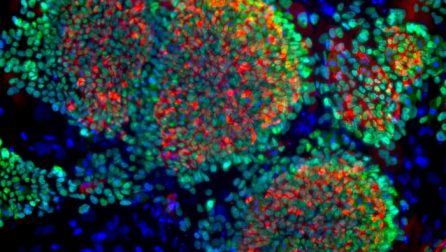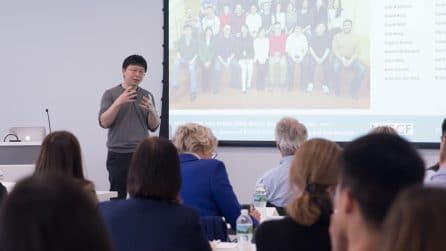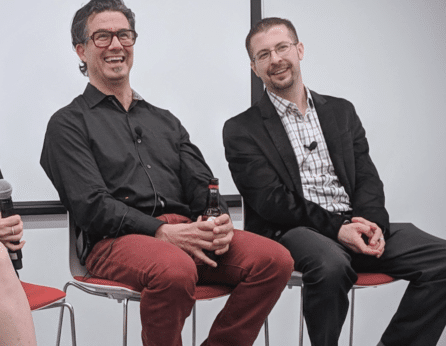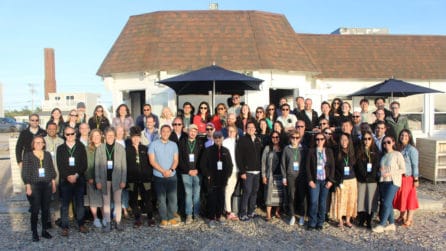Stem Cells, mRNA Vaccines, and Snakes: An Evening with Derrick Rossi
NewsEarlier this month, NYSCF hosted an intimate conversation with Interim CEO Derrick Rossi, PhD, who shared the journey of his already long and storied career in science: everything from becoming a NYSCF – Robertson Investigator to founding Moderna to envisioning a better way to treat snake bites [more on that later]. Read on to learn more about his vision for the future of biomedicine.
How did your mRNA and stem cell research lead to the founding of Moderna?
“We originally developed the mRNA technology to achieve a goal related to stem cell science in 2008,” remarked Dr. Rossi. “When we published our study it was big news at the time because it opened up the possibility of efficiently making pluripotent stem cells to model disease – meaning that any of hundreds of cell types in a person could be made from these incredibly powerful cells. Of course the long-term vision was that these stem cells could eventually be used in cell-based therapies for cell, tissue, or organ transplantation.”

In addition to this incredible promise for cellular therapy, Dr. Rossi also realized that the mRNA technology had potential for addressing myriad other health challenges; particularly, genetic disease and cancer. He noted that there are about 6,000 genetic diseases that afflict humans. He founded Moderna in 2010 based on the idea of applying the mRNA technology to treat such human diseases which had no known therapy.
“In genetic diseases, DNA mutations exist in genes that give rise to mutated mRNA, and then that mutated mRNA leads to the synthesis of non-functional or dysfunctional proteins which are the bad actors that lead to disease. Essentially all genetic diseases follow this basic paradigm: mutated DNA makes mutated mRNA makes mutated protein, which underlies disease. The approach was simple: we could potentially bypass the foundational mutation in the DNA by introducing unmutated “healthy” mRNA to patients to restore normal protein function, thus treating disease at its most fundamental levels. That was the idea that I founded Moderna on.”
How did the name Moderna come to be?
“When we first developed the technology in my lab at Harvard Medical School, all of the scientists in my lab referred to it as ‘mod-RNA’, which was short for modified-mRNA – the mRNA we made utilized modified building blocks,” he said.
Dr. Rossi shared that after some unsuccessful brainstorming, one evening at home he had the idea to just merge the mod-RNA term into one word.
“I thought, well, we have something right there, mod-RNA, let’s just remove the dash and turn it into an ‘e’, and you get Moderna. That’s where the name came from.”
How could mRNA vaccines be used to treat diseases like cancer?
“Cancer is a genetic disease,” said Dr. Rossi. “Mutated DNA makes a bad mRNA, which makes a mutated protein that hijacks your cells making them divide without controls.”
“The genes that get mutated in human cancer are recurrent. And that’s really the only good news about cancer – it uses the same bad actors over and over again. So if you know what mutations those are, and we do, you know what DNA sequences are typically mutated and thus you should be able to make a vaccine against such a mutated sequence.”
“The idea is if a vaccine was given to someone healthy, targeting a recurrent mutated sequence, then if the person eventually got such a mutation, their immune systems might attack it early before the cancer had the time to establish itself. This is of course what vaccines do – they prime your immune systems to respond quickly to drivers of disease, be they pathogens such as SARS-CoV2, or influenza, or potentially recurrent cancer drivers.”
When you look back at your career, what other advancements did you find most exciting?
One tool that has advanced scientific discoveries over the past few decades is gene editing, and Dr. Rossi is hopeful about the promise of gene editing for preventing and treating disease.
“With gene editing technology, we have the ability to go right to the DNA level and make changes (edits) at the level of the DNA” Dr. Rossi explained. “There was this great editing technology which came out called CRISPR [pioneered in part by NYSCF – Robertson Stem Cell Investigator Feng Zhang, PhD], and it has amazing efficacy and specificity for correcting mutated genetic sequences.”

One area where Dr. Rossi envisioned gene editing might be impactful was in the treatment of HIV infection that initiates with a gene called CCR5 that essentially acts as a door that the HIV virus uses to get inside cells. Dr. Rossi had known about a clinical case in which a man named Timothy Brown, referred to as ‘The Berlin Patient’, who was HIV positive and became the first person ever to be cured of his HIV infection.
“The Berlin Patient was a man who was unlucky twice and very lucky once,” noted Dr. Rossi. “He was first HIV positive, which of course, is unlucky. But then he got very unlucky in that he developed a type of blood cancer called acute myeloid leukemia (AML) which required a bone marrow transplant to treat.”
“He got very lucky, however, when his transplantation doctors gave him bone marrow from a donor who had a naturally occurring mutation in the CCR5 gene which prevented HIV from getting into cells but otherwise had no effect on the normal function of bone marrow cells (which is to give rise to all of our blood cells). So in getting transplanted with cells that were resistant to HIV infection, he became the first person to be cured of HIV. Of course he was also cured of his AML which was life saving.”
“When the CRISPR technology was first developed, I immediately thought to go after CCR5 and make a similar edit in bone marrow stem cells that had cured the Berlin patient. HIV is still a global problem. After several years of work, we published a paper where we showed that we could make this edit in CCR5 using CRISPR in stem cells and that would be a way to lead to a therapy for people with HIV.”
What did the NYSCF – Robertson Investigator Program do for your career?
“Well, there are three main drivers of science: money, people, and ideas,” noted Dr. Rossi. “The money from the NYSCF award really gave my lab the runway to do experiments and pursue big ideas.”

“But it wasn’t just the money. Each year we would have an annual retreat where the NYSCF scientific community would gather and discuss our latest work and get inspired by the work of others. I was at the retreat one year and I was particularly struck by a presentation from Case Western University’s Paul Tesar on his work in multiple sclerosis. At the coffee break, I asked him “who are you talking to?” and he assumed I meant which journal was he considering sending his study to for publication. But what I really meant was – which venture capital firms are you talking to in order to move your incredible work towards patients? From that meeting I partnered with Paul to help move his incredible science towards a treatment for multiple sclerosis and we formed a company called Convelo Therapeutics where we’re working on getting therapies to patients.”
When you look at the field of biomedical science and discovery, what excites you the most?
One area Dr. Rossi is interested in is optimizing “delivery” of therapies to hard to reach cells and tissues.
“When I say ‘delivery’ I don’t mean UPS, I mean targeting therapies to where they need to be in the body,” he laughed. “We have to get treatments to the right cells in the body, and for some organs, like the brain, that’s tough. I would love to see innovations where we can essentially put little address tags on our therapies and send them to the right tissues.”
Another one of your interests is in snake bites, correct?
“I grew up with snakes. I had an older brother that brought all manner of crazy animals in through the front door. We had squirrels, alligators, piranhas, snakes – you name it.”
“I then found out later that 125,000 people every year are killed by snake bite, and 450,000 are maimed. These people are also from largely disenfranchised groups – they’re the people working in the field without boots or ready access to treatment should they be bitten. It’s a real problem in Africa, India, Asia, and other places along the equator.”
“So one thing I’m interested in is whether we could use mRNA to do tailored shots of ‘anti-venom’ for people that are bitten, because mRNA is very fast, and it can be very tailored. And having these could potentially help a lot of people.”
What is most exciting to you about NYSCF?
Dr. Rossi looks forward to what NYSCF will enable with its foundations in technology and team science.
“NYSCF is exciting, broadly, because it’s a combination of several things: it’s a funding institution, a research organization, and an educator. It’s a science hub that attracts really great scientists that then become part of this larger community.”

“Susan Solomon had this vision of automating this bioscience. I don’t know how she had this vision so early on, because at the time, it sounded quite kooky and next-to-impossible. Yet here we are.”
“Scientists know that when we do experiments, it’s typically a lot of hands-on work. It’s someone pipetting seven microliters here, ten microliters there, then heating at an exact temperature for an exact amount of time. You can introduce human error when you’ve got all of these human variables. So this automation of stem cell science was really visionary and important.”
“NYSCF has also led the way in applying artificial intelligence to this pipeline, and that opens the door for us to do incredible things in disease research and drug discovery.”
What advice do you have for taking discoveries out of the lab and into the clinic?
“You have to be a forward looker. You really have to try to envision all the way through to clinical study,” Dr. Rossi noted.
“Probably everything is solvable in science at some point or another, but sometimes you’re confronted with a concrete wall. And actually, anybody can get through that concrete wall – you may need to chew through it with your teeth for nine years and in so doing have lots of dental implants, but you will eventually get through that wall in you are determined enough. And then you have to say, well, do I have nine years? Do I have that many teeth? Do I have good dental insurance? And will somebody fund me to do that?”
“Or maybe you can look around and see if someone else has invented a door or a window that could make it easier. So it’s a lot of vision, timing, and community science.”

